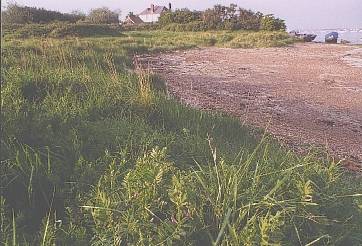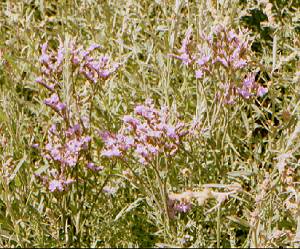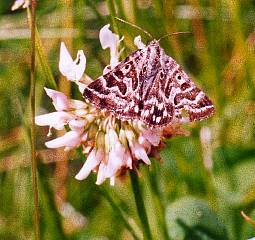Milton Locks
 Milton Locks Reserve is at the end of Locksway Road in Portsmouth, near the Thatched House pub. Grid ref. SZ677998. The reserve is managed by Portsmouth City Council. It is adjacent to Eastney Lake,which is part of Langstone Harbour.
Milton Locks Reserve is at the end of Locksway Road in Portsmouth, near the Thatched House pub. Grid ref. SZ677998. The reserve is managed by Portsmouth City Council. It is adjacent to Eastney Lake,which is part of Langstone Harbour.
Don't confuse this site with its big brother, Milton Common, a bit further north. Milton Locks Reserve is about 1 Hectare and represents a small fragment of natural coastline, showing the transition from harbour to land without a concrete sea-wall. A few old wrecked boats still inhabit the harbour here, giving just an echo of the mid 20th century when house-boats were packed in here. Sea Spurrey, Sea Purslane, Sea Aster and Sea Lavender, pictured below, can be found at the high water mark.
 Growing near the beach are the distinctive grey-green leaves of Sea-couch grass, and this gives way to less specialised grasses and bramble bushes further inland. Much less obvious are patches of Hard grass, a diminutive species of grass which grows near the sea. Look closely at the top of the beach and you realise that what appears to be sand is actually made up from thousands of tiny empty shells. These are Laver Spire snails, which feed on algae. On the mudflats just below the shingle beach is a small stand of Cord Grass, Spartina anglica. This is a hybrid species which until recently was threatening to take over the harbours, but it is now declining.
Growing near the beach are the distinctive grey-green leaves of Sea-couch grass, and this gives way to less specialised grasses and bramble bushes further inland. Much less obvious are patches of Hard grass, a diminutive species of grass which grows near the sea. Look closely at the top of the beach and you realise that what appears to be sand is actually made up from thousands of tiny empty shells. These are Laver Spire snails, which feed on algae. On the mudflats just below the shingle beach is a small stand of Cord Grass, Spartina anglica. This is a hybrid species which until recently was threatening to take over the harbours, but it is now declining.
 The Mother Shipton moth, pictured right, takes its name from the mythical witch because it is just possible to see a likeness in the wing pattern. Start by regarding the black dot as her eye. This is a day-flying moth, with larvae that feed on clovers. About six were seen late June 2002.
The Mother Shipton moth, pictured right, takes its name from the mythical witch because it is just possible to see a likeness in the wing pattern. Start by regarding the black dot as her eye. This is a day-flying moth, with larvae that feed on clovers. About six were seen late June 2002.
Great Green Bush-crickets can be heard in summer, but are pretty difficult to see. Twelve species of butterflies have been recorded. Kestrels keep an eye on the grassland for small mammals, and the more elusive Cetti's Warbler may be heard. An urban site like this gets its share of litter and junk from the harbour. The odd piece of planking is of some benefit, providing a warm, dark haven for slowworms. A Common Lizard was seen sunning itself on some black plastic.
There is no livestock here to keep the vegetation in control. Volunteers are needed in the summer to keep the paths open, and to do more extensive cutting of the bramble bushes in winter.
The Outlier
The small patch behind the pub is also part of the reserve, and the rather rank vegetation is being managed to encourage a greater range of plants. A bold solution would be to strip off the top-soil and try to establish plants that flourish in sand or shingle.
Myrtle's Hedge
On the north side of the first car-park is a short section of hawthorn hedge, planted by the Portsmouth Urban Wildlife Group in 1990.
Back to Sites
 Milton Locks Reserve is at the end of Locksway Road in Portsmouth, near the Thatched House pub. Grid ref. SZ677998. The reserve is managed by Portsmouth City Council. It is adjacent to Eastney Lake,which is part of Langstone Harbour.
Milton Locks Reserve is at the end of Locksway Road in Portsmouth, near the Thatched House pub. Grid ref. SZ677998. The reserve is managed by Portsmouth City Council. It is adjacent to Eastney Lake,which is part of Langstone Harbour. Growing near the beach are the distinctive grey-green leaves of Sea-couch grass, and this gives way to less specialised grasses and bramble bushes further inland. Much less obvious are patches of Hard grass, a diminutive species of grass which grows near the sea. Look closely at the top of the beach and you realise that what appears to be sand is actually made up from thousands of tiny empty shells. These are Laver Spire snails, which feed on algae. On the mudflats just below the shingle beach is a small stand of Cord Grass, Spartina anglica. This is a hybrid species which until recently was threatening to take over the harbours, but it is now declining.
Growing near the beach are the distinctive grey-green leaves of Sea-couch grass, and this gives way to less specialised grasses and bramble bushes further inland. Much less obvious are patches of Hard grass, a diminutive species of grass which grows near the sea. Look closely at the top of the beach and you realise that what appears to be sand is actually made up from thousands of tiny empty shells. These are Laver Spire snails, which feed on algae. On the mudflats just below the shingle beach is a small stand of Cord Grass, Spartina anglica. This is a hybrid species which until recently was threatening to take over the harbours, but it is now declining. The Mother Shipton moth, pictured right, takes its name from the mythical witch because it is just possible to see a likeness in the wing pattern. Start by regarding the black dot as her eye. This is a day-flying moth, with larvae that feed on clovers. About six were seen late June 2002.
The Mother Shipton moth, pictured right, takes its name from the mythical witch because it is just possible to see a likeness in the wing pattern. Start by regarding the black dot as her eye. This is a day-flying moth, with larvae that feed on clovers. About six were seen late June 2002.